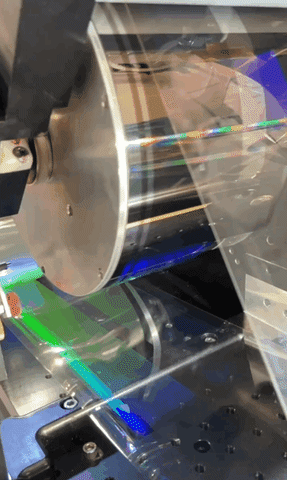Who are we, what are we doing, and why?
SMS’s Material Scientist, Dr. Nicky Cates, stopped by the It’s a Material World Podcast to answer these questions, and more. This is also a great listen for any aspiring MSE!
We’ve successfully created a dust-mitigating nanostructure!
The past 6 months have been the best yet for Smart Material Solutions. This included a breakthrough in our efforts to create a Passive Dust-Mitigating surface for NASA through a Phase 1 SBIR Project with Prof. Chih-Hao Chang’s group at UT Austin that concluded in November.
The result: we created a nanostructured surface that reduced dust coverage by 93% compared to a smooth surface of the same material. The video below shows how a lunar dust simulant slides right off our nanostructured surface, while sticking to a smooth surface of the same material. The SEM image shows a side-angle view of the seam between the structured (right) and smooth (left) regions of the same sample. The division is dramatic, and represents a potential game-changing advance in NASA’s efforts to reduce dust adhesion on critical components, including solar panels, radiators, camera lenses, and spacesuits. Results have been submitted for review in a publication led by Prof. Chang and his student, Samuel Lee.
NASA Phase II SBIR funded
Our success in Phase 1 led to a $750,000 Phase 2 contract to improve surface performance, transfer the patterns into several more space grade materials, demonstrate imprinting roll-to-roll, create application demos, and further understand the physics that drive this phenomenon. We’re partnering once again with UT Austin, who will test our samples in a lunar simulation environment and lead the effort to study particle adhesion physics, along with Microcontinuum, Inc. who will replicate our molds using roll-to-roll nanoimprint lithography.
Application demos will include solar cover glass, visible optics, and radiator films
Army research underway
The US Army has been our biggest supporter, and work continues to use our patterning methods and roll-to-roll processes to create large area anti-reflective surfaces and metamaterials for multiple national defense applications. We’re partnering with the University of Delaware (UD) and Microcontinuum, Inc.. UD Prof. Mark Mirotznik, his graduate student Alex Winters, and the SMS team recently published on the topic in the Journal of the Optical Society of America B.
Microcontinuum imprinted more than 500 linear feet of our anti-reflective motheye film using roll-to-roll NIL.
Our next big pitch: the Army’s XTech Clean Tech competition
Dr. Nicky Cates, our resident solar expert, is leading an effort to pitch our light-trapping and dust-mitigating surfaces to the Army to improve the flexible, thin-film solar panels that power electronics on the battlefield. We’ve crossed the first hurdle, as our white paper was selected for a live pitch next week. If we’re selected, we’ll have a great line on more than $2M in funding to focus on enhancing the performance of thin-film solar cells - one of our most promising application targets.
Blog Posts
Check out our two new blog posts, and the interesting videos within!
Diamond Turning: a Single-Step Process to Create Precise Parts with a Reflective Finish






